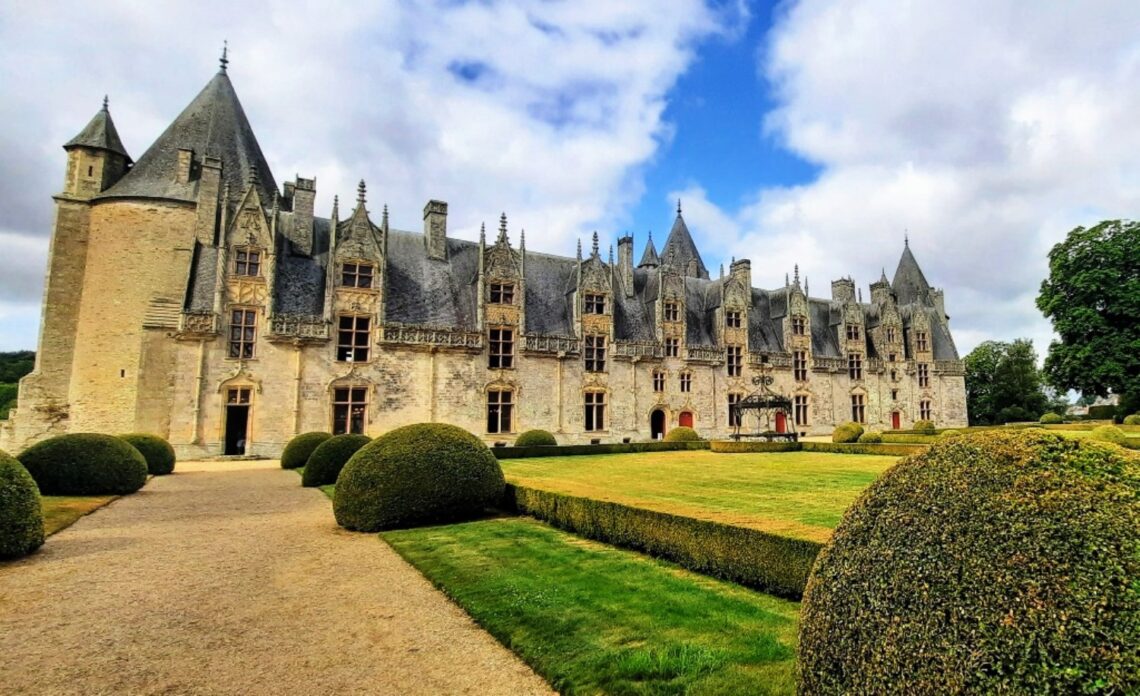
The Most Beautiful Fairytale Castles in France
Let’s talk about fairytale castles in France, because there are so many. We’ve covered fairytale castles in Germany, however it’s not the only country in Europe with numerous castles. France has its fair share of castles. I’ve asked my fellow travel bloggers which fairytale chateau in France they love and added my favorites.
Fairytale Castles in France
When wondering are there castles in France? Then read on, because yes, there are and there are many. All of them are also perfect stops on road trips.
Château de Castelnaud, Castelnaud-la-Chapelle, Nouvelle-Aquitaine
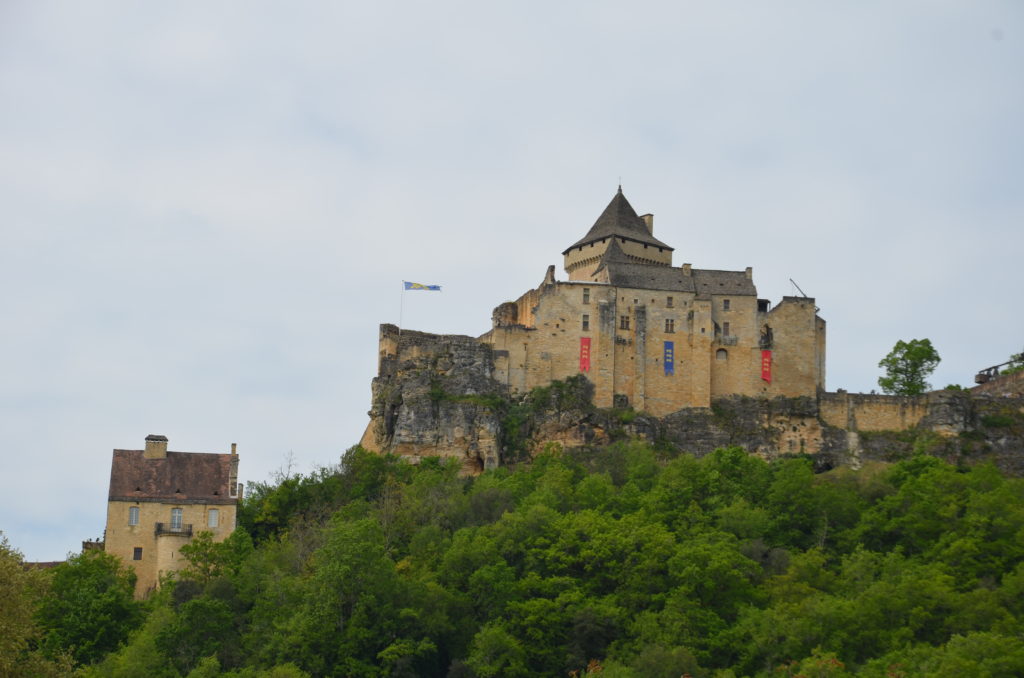
Contributed by Cosette from KarsTravels.
Located in the town of Castelnaud-la-Chapelle is the beautiful castle of Castelnaud. The town is in the Dordogne region in Southern France. The Dordogne with kids is perfect and Castelnaud is the top thing to do.
Castelnaud was built in the 12th century. The medieval castle is situated on a rocky cliff towering high above the Dordogne river. From the castle you’ll have a beautiful panorama view on the Dordogne valley.
Inside the château is the Musee de la Guerre au Moyen Age (Museum about War in the Middle Ages). Inside in the castle and outside on the walls, gallows, enormous catapults and other weaponry is displayed. The explanation on the signs is in French, but there are leaflets available in several languages.
The castle is surrounded by a walled medieval village. There are small cobblestone streets in the village with shops, demonstrations and restaurants. The streets get narrower and steeper the closer you get to the castle.
The castle is open year round. Tickets cost €9.60, kids under the age of 10 are free. There’s paid parking, outside the village. It’s a short walk to the castle walls. However you need to cross the village first before you reach the castle. Take half a day for a visit.
Châteaude Josselin, Josselin, Bretagne

Contributed by Faith from XYUandBeyond.
Lying on the banks of the River Oust, northeast of Vannes in Brittany, sits Josselin. The town sits in the shadow of the stunningly beautiful Château de Josselin which dominates the entire area.
Josselin Castle has been home to the Rohan family for more than ten centuries. Built in the 11th century by Lord Porhoët, the castle was destroyed for the first time by Henry II Plantagenêt. It was rebuilt and fortified in 1370 with nine towers and a keep.
Cardinal de Richelieu ordered the destruction of the castle in around 1629 as Henri de Rohan converted to Protestantism and Richelieu ordered the castle to be destroyed and five of the nine towers were torn down.
The castle was neglected for more than three centuries as the Rohan’s were banished from Brittany and didn’t return until 1860. By that time the castle was uninhabitable with a collapsed roof. By the late 19th century the Castle had been restored and it is now open to the public.
In the Castle, you will only see the ground floor, which has 5 rooms, one of which is the portrait gallery. One portrait was a painting of Georgine de Serent who was tragically killed (in 1815) when the lace of her dress caught on fire while she was getting ready for dinner.
The tour includes the 19th-century dining room, the drawing room with its impressive 16th-century fireplace and library housing more than 3,000 volumes dating from the 17th century.
Guided tours around run from April to September and twice a day the tours are in English. A free self-guided tour of the Chateau is €10.80 for an adult and €5.50 for children.
Les Trois Châteaux de Ribeauvillé, Ribeauvillé, Grand Est

Contributed by Sabrina from Shades of Summr.
Les Trois Châteaux de Ribeauvillé are located in the beautiful city of Ribeauvillé in Alsace. You can find them overlooking the city from the hill next to the city.
They are not so much one fairytale castle, but a trio of medieval castles on the same hill. They are called Saint-Ulrich, Girsberg, and Haut-Ribeaupierre, the last one is the oldest and most mysterious.
These castles have got quite a long history dating back to the 13th century. The Lords of Ribeaupierre, a powerful family, built them for defense in medieval times.
You can best visit them on a short hike from Ribeauvillé. It takes about an hour to reach them, and the hike is not too difficult. Visiting the three castles is free, and it will take you a couple of hours to explore all of them.
After the hike, make sure to visit the Restaurant a Trois Châteaux at the bottom of the hill for a traditional Alsatian meal and wine directly from Ribeauvillé.
Château du Rivau, Lémeré, Centre-Val de Loire

Contributed by Claire from Loire Lovers.
Château du Rivau is one of the most enchanting castles in the Loire Valley, even though it is not as famous as many others. Located near the town of Chinon, between Saumur and Tours, it is a little isolated but this is part of its charm!
The term “fairytale castle” is often used in the Loire and sometimes in an exaggerated way, but not for this castle!
Built in the 15th century, it offers a harmonious marriage of medieval and renaissance architecture and a magical atmosphere. Plus, it is home to 15 remarkable gardens ensuring the preservation of the horticultural heritage of the Loire Valley.
We recommend spending at least half a day exploring the castle. However, you can also stay in one of the rooms in the royal stables, facing the castle! Spending the night in a Loire Valley castle is an unforgettable experience.
The castle is easy to explore and great for children as it offers specific activities such as treasure hunts and booklets. Tickets are sold at the entrance for adults and kids under 18 years of age. And they also propose family tickets.
Château de Versailles, Versailles, Île-de-France
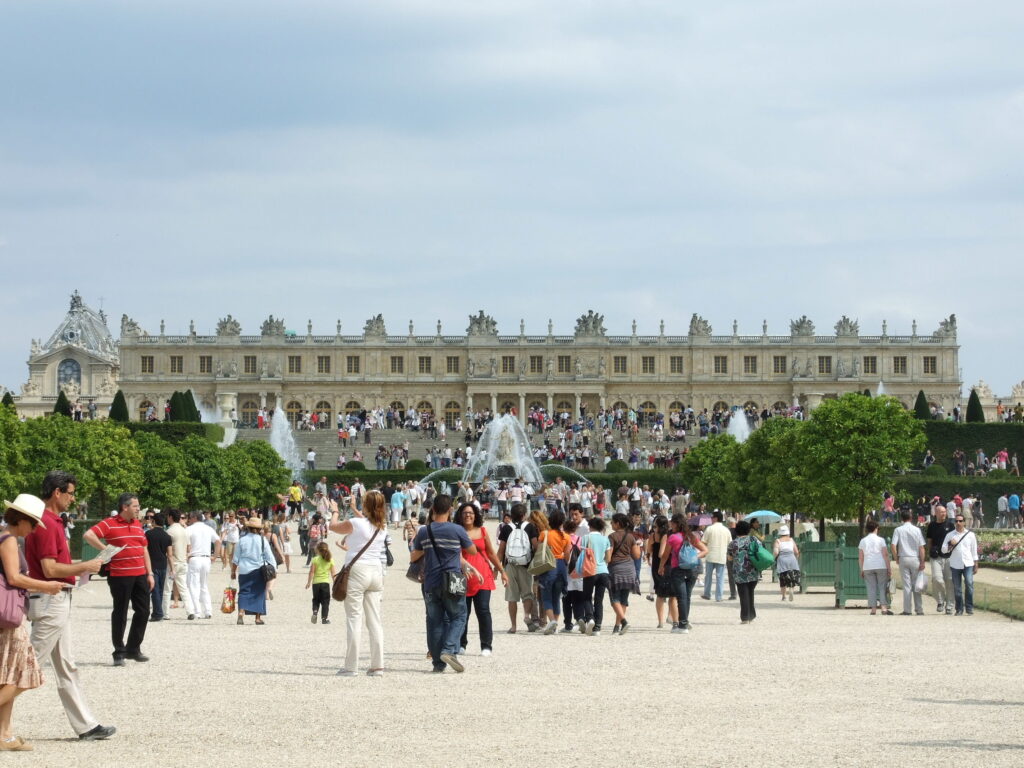
Contributed by Cosette from KarsTravels.
One of the most iconic landmarks of Paris is the beautiful palace of Versailles. The palace is actually not in the city of Paris itself, it’s in the city of Versailles, which is located west of Paris.
The palace is one of the most spectacular castles you can imagine, mostly because of the Hall of Mirrors. This is one of the most famous rooms, you’ll usually see a picture of this room when they show pictures of Versailles. You have to see it for yourself to believe it. It’s beautiful and over the top. The hall is also the location where the Treaty of Versailles was signed in 1919.
The château was originally built by Louis XIII and expanded by King Louis XIV, making it one of the largest castles in the world. It’s the former residence of French royalty and is a national museum since 1792. It’s also a UNESCO World Heritage Site.
Next to the palace the gardens are huge and amazing. You can wander around them for hours. The gardens are manicured and have classical statues and lots of water features.
The gardens are free to visit. Access to the palace is free for under 18. Otherwise it will cost €19.50. You’ll have to book online to get a timed entry. Exploring the palace of Versailles and its gardens will take the whole day.
Château de Saumur, Saumur, Pays de la Loire

Contributed by Hannah from HH Lifestyle Travel.
Combining fairytale castle views and the opportunity for wine tastings and boat tours, Saumur is a wonderful weekend destination in the Loire Valley, France. Saumur Castle sits overlooking the town, and the confluence of the Loire and Thouet rivers; and now houses a decorative arts and horse museum.
The first fortress was built on the site in the 10th century, but like most French châteaux it has been added to, destroyed, and rebuilt many times. The current octagonal towers were added in the 14th century. It served as a prison for two centuries, but restoration and the transition to a museum began at the beginning of the 1900s.
You can visit the castle grounds for free, and it is a short (albeit steep) walk from the town center. Wandering the grounds offers the opportunity to admire the outside of the building and enjoy the views from the ramparts.
Access to the château and museum has a small charge starting at €8.50, with reduced rates for children and students. Children under 7 are free. There are no guided tours, but the information leaflets are available in several languages. There is an annual closure in January and low-season hours differ from summer hours.
Give yourself 1-2 hours to visit; and bring a picnic to enjoy on the ramparts.
Château de Jumilhác, Jumilhác-le-Grand, Nouvelle-Aquitaine

Contributed by Hannah from Nouvelle-Aquitaine Travel.
Château de Jumilhac is a fairytale vision nestled in the northern part of the Dordogne in south-west France. It isn’t the usual government or commune-owned castle, it is privately owned and opens its doors for a true glimpse into château life.
Only available to visit via guided tour, you will explore the inside of this fascinating building and learn about the history of the Jumilhac family. The central part of the castle, with its many turrets, was built in the 15th century, with the two wings added later. It has a walled courtyard and a huge walled and manicured garden at the back.
Prices range from €5.50 – €10.50 and include access to the public parts of the castle and gardens. Tours last around an hour, and you can self-guide around the gardens in your own time. The gardens and night visits are only available in the spring and summer. The castle is also available for rent for events, weddings and conferences.
Out of all the historical sites in the Nouvelle-Aquitaine, Château de Jumilhac has the most fairytale appearance, and offers visitors a glimpse of how real families live in such a grand building.
Château du Haut-Koenigsbourg, Orschwiller, Grand Est

Contributed by Cosette from KarsTravels.
Haut-Koenigsbourg castle is a castle situated on a rocky spur, from which you can see the Upper Rhine Plain. It’s located in Northern France in the Alsace.
It’s a medieval castle that is strategically located, however it was burned and abandoned during the Thirty Years’ War. It was rebuilt again from 1900 to 1908 by order of the German Kaiser Wilhelm II. As much as it was at the start of the Thirty Years’ War.
Nowadays it’s a tourist site, that attracts over 500.000 visitors a year.
The castle is beautiful and the views on the valley below are wide and far. It’s immediately clear why it was strategically so important.
Entrance to the castle costs €9.00 for adults. Kids 6 till 17 years old pay €5.00. Kids under 6 are free of charge. A couple of hours should be enough for a visit.
Château de Tennessus, Amailloux, Nouvelle-Aquitaine

Contributed by Dean from Reasons To Visit.
While it may not be the largest or most architecturally striking castle in France, Chateau de Tennessus offers a unique experience that will forever live in your memory.
Located near the historic town of Parthenay, about halfway between Paris and Bordeaux, this 600-year-old castle has a rich history.
From being owned during the 15th Century by Catherine of Luxembourg, to being marked for demolition during the revolution when the owners fled the country, only to have the order reversed at the last minute.
And it is this reprieve that now allows you to spend a night or two living as a French noble in a charming castle surrounded by a moat and protected at night by a raised drawbridge.
Tennessus is quite remote making it an ideal road trip stop, but difficult for anyone without a vehicle. A car is also essential to get to the nearby villages, like Parthenay, for a meal.
A continental breakfast is included with all stays and can be taken in your room or the castle dining room, while they also offer an optional special treat in the form of a lunch picnic basket filled with traditional regional delicacies.
It is an incredible experience to stay in a place as old and authentic as this chateau, which is exactly why we travel!
Château de Gordes, Gordes, Provence-Alpes- Côte d’Azur

Contributed by Kristin from Scotland Less Explored.
Gordes Castle is in Luberon, Provence. The closest city is Avignon which is circa 40 km and 1 hour and 10 minutes drive away.
What makes the castle special is its location high on a hill and the picturesque village that surrounds it. The best views of the castle are from the roundabout in the center and the viewpoint called Point de vue sur la ville de Gordes, a short walk from the village.
The first mention of the castle was in 1031. Back then it was a fortified castle which looked much like many castles in Scotland. Gordes Castle was redesigned and extended in the 14th century and has a blend of architecture from the Middle Ages and the Renaissance era.
Over the years the castle has had many uses including a store for the harvest, a prison and a place to house troops. Later it housed the town hall, the post office and a boy’s school. It is often described as being the heart of the village.
It is free to walk around the castle. A few rooms inside can be visited for €6 but the main reason to come here is to see the castle from the outside and to explore the village. The castle itself can be viewed in 30 minutes but plan to spend half a day seeing Gordes itself.
The narrow alleyways that run up and down the hill have been renovated over the years and the façades of all the houses are in local stone. Make sure you wear comfortable shoes because most are cobblestone. Cute shops and good restaurants line the streets.
Château des ducs de Bretagne, Nantes, Pays de la Loire

Contributed by Cosette from KarsTravels.
Smack in the middle of the city of Nantes is the castle of the Ducs de Bretagne. From here the province of Bretagne (Brittany) was ruled for centuries. The castle is situated on the banks of the river Loire.
It’s a medieval castle that was built in 1207 and rebuilt in 1466. Nowadays the historical museum of Nantes is situated inside the castle. You’ll learn all about the history of the castle and the city of Nantes.
Fun detail of the castle is that there’s a slide, which you can leave the castle with. You do have to pay extra for it.
Entrance to the rampart walk, courtyard and moat gardens is free of charge. Admission to the museum is €9.00. Aged 18 till 25 is €5.00. Aged under 18 are free of charge. Take about 2 to 3 hours for a visit.
Château Comtal, Carcassonne, Occitanie

Contributed by Kim from Explore Your Bucket List.
The majestic Carcassonne castle, located in the Aude region, dates to the 11th century. Over the years, the chateau received additional fortifications, enormous towers, a moat and eventually a second rampart around the outside, making it a true fortress. These additions are what give the castle its immense size and provide a striking view from the surrounding countryside.
Inside the walls, is a very well-preserved medieval city where some people still live to this day. The cobblestone streets are quaint, and you can wander around the maze of narrow passageways. There is plenty to see including shops, restaurants, a museum, and a beautiful Basilica. The entire monument is designated as an UNESCO Heritage Site.
Tickets to visit the castle and ramparts are €9.50 for adults and children under 18 are free. You can also do a self-guided tour with an audio guide for €11.00.
Carcassonne is the best preserved of the Cathar castles. If you are interested in this period of history, be sure to check out the ruins of the other three Cathar castles in the region. A highlight of Carcassonne is walking around the ramparts as you can have amazing views of the neighboring areas that are full of vineyards with a backdrop of beautiful mountains. You should plan to be there for at least half a day to explore this sight adequately.
Château de la Rochefoucauld, La Rochefoucauld-en-Angoumois, Nouvelle-Aquitaine

Contributed by Kylie from Life in Rural France.
Château de la Rochefoucauld is owned by the Rochefoucauld family and sits high on a hill overlooking the village of the same name in the beautiful Charente region of Southwest France.
Built in the 11th century, the family still lives in some of the rooms.
When you visit you’ll see the boudoir of Marguerite de Valois and walk through twenty beautifully furnished rooms still showcasing tapestries, paintings, drapings and furniture from centuries ago.
The kitchens take you back to the 12th century with huge fireplaces, massive copper pots and pans, and flagstone floors, giving you an insight into what life would have been like for a kitchen maid.
The circular staircase takes your breath away and is said to be designed based on some drawings by Leonardo Da Vinci.
Entry to the castle is €12 for adults and €5 for children and you can choose to do a self-guided tour or a two-hour tour with a guide.
At the foot of the castle is a chocolate factory where they make the chocolate on-site and a fantastic steak restaurant called Chez Steph.
Château de Péronne, Péronne, Hauts-de France

Contributed by Cosette from KarsTravels.
The castle of Péronne is in northern France in the town of Péronne, close to the river Somme. It dates from the 13th century and was built by order of Philips II. It’s built in a strategical place and has been laid siege to on several occasions.
During the First World War the castle was partly destroyed and restored again. Till this day the castle still has its original shape. However not all the towers of the castle were restored.
Inside the castle is housed the Historial de la Grande Guerre, a museum on the history of the First World War. There’s also a small part of the museum dedicated to the history of the castle. The castle s close to the First World War battlefields of the Somme.
There’s a new part built inside the castle walls in which part of the museum is located.
The museum is closed from halfway December till the end of January. Entrance costs €10, kids 7 till 16 pay €5, kids 6 and under are free of charge. Take half a day to visit the museum.
Château des Baux-De-Provence, Les Baux-de-Provence, Provence-Alpes-Côte d’Azur

Contributed by Lucy and Dan from Thoroughly Travel.
Situated on a 250-meter-high rocky plateau in South East France, Château des Baux-de-Provence provides stunning panoramic views of the Alpilles and is one of the most magical fairytale castles in France. Whilst the castle itself was built in the 10th century, evidence of habitation at the Château dates back over 8000 years. Located in a rural commune of the same name, visitors to Château des Baux-de-Provence can learn about the medieval history of the region, as well as witness a demonstration of the biggest trebuchet in Europe.
The charming city of Arles, with its many Roman remains, is just a 30 minute drive away. While taking a wildlife safari in the Camargue, where you may see flamingos and wild horses, makes for a great day trip. Château des Baux-de-Provence only takes half a day to visit, but it’s worth spending a few days in the area to explore all that the Bouches-du-Rhône region in Southern France has to offer.
Château des Baux-de-Provence is easily accessible by car from major cities including Avignon, Nîmes and Arles. Marseille is the largest, closest international airport. There is a small entrance fee for the castle and parking is charged at an hourly rate.
Château de Chenonceau, Chenonceaux, Centre-Val de Loire

Contributed by Pauline from France Pocket Guide.
Located in the beautiful Loire Valley, the Château de Chenonceau is one of the most famous castles in France.
It used to be a royal castle and was given to Diane de Poitiers by King Henry II. She was the king’s favourite mistress and for this reason, was offered the most beautiful castle.
Later on, when King Henry II died, Catherine de’ Medici, his widow, became Queen Regent and decided to take possession of the castle again. She ruled France for years from this very castle.
Unlike other castles in the Loire Valley, Chenonceau is quite small but it’s absolutely stunning. It feels quite ‘homey’, you can really tell that people used to live there on a permanent basis. It also features a beautiful bridge over the river as well as French gardens.
Altogether, you will need 2 to 3 hours to visit the chateau and the estate but you can easily spend the entire day there if you want to go for walks.
It’s only a 20 minutes drive from Amboise and some of the other chateaux in the region. You can easily get there by car. There is a large car park at the entrance.
You can purchase your ticket online or directly at the reception. The entrance fee is €15,50 per adult. Dogs are allowed on the estate but not in the castle. You can also find a small café on the side for refreshments.
Château de Vincennes, Vincennes, Île-de-France

Contributed by Christine from Journey To France.
Located in the town of Vincennes, which is in the eastern suburbs of Paris, France. It is relatively close to the center of Paris. The Château de Vincennes is one of France’s most significant medieval castles. And also one of the best Chateaux near Paris.
This 13th-century medieval castle was built as a hunting lodge for King Charles V and later expanded into a fortified royal residence. It became a symbol of royal power and a military stronghold in French History.
There are must-see places while visiting the Château de Vincennes. One of the main attractions of this charming castle is the Bois de Vincennes.
This beautiful park offers green spaces, a lake, and various recreational activities. You can also climb the Donjon de Vincennes to watch the panoramic view of the surroundings. There are also exhibits about the castle’s History inside the Donjon de Vincennes.
There are several ways to get to Chateau de Vincennes. Take the Paris Metro line or the RER * Regional Express Train. Other options are buses and private cars. If you are visiting the Château de Vincennes soon, you can book a tour to explore the castle. You can spend an hour and a half to explore this magnificent castle. The entrance fee is €9.50.
Château de Villandry, Villandry, Centre-Val de Loire

Contributed by Michelle from Intentional Travelers.
Chateau Villandry is found in the Loire Valley near Tours. Only three hours from Paris, it’s the last of the great Renaissance chateaux.
The original fortress was constructed in the 11th century and acquired by Jean Breton, finance minister of Francois I, in 1532. At one point it became home to Napoleon Bonaparte’s brother.
What really stands out about Villandry Castle today, is its well manicured and expansive gardens. With peaceful pathways through the woods, a large pond with swimming swans, a labyrinth, playground, and several impressively landscaped gardens, it’s easy to spend a couple hours exploring the castle and grounds.
Tickets can be purchased online or on site. Audioguides are available as well as regular guided tours in French.
Designated a Monument Historique and UNESCO World Heritage site, Chateau Villandry and its gardens are a great stop for visitors to the Loire Valley.
Grand Trianon, Versailles, Île-de-France

Contributed by Gladis from Happiness On The Way.
Nestled within the enchanting grounds of the Palace of Versailles in France, you’ll discover a hidden gem: the Grand Trianon. This elegant palace, often overlooked in favor of its more famous neighbor, is a captivating destination that promises a fairytale experience.
The Grand Trianon was commissioned by King Louis XIV in the late 17th century as a retreat from the formalities of the main palace. It was used by the king to escape the bustling court life and spend time with his mistress, Madame de Montespan.
I recommend dedicating 3-4 hours to explore the Grand Trianon. The Grand Trianon requires a separate ticket from Versailles (12 €), but it’s included in the Paris Museum Pass. This ticket also grants you access to the Petit Trianon and the Queen’s Hamlet.
As you explore the palace, marvel at the exquisite architectural details that showcase the luxury of the French monarchy. The Grand Trianon is renowned for its distinctive pink marble columns, giving it a unique and romantic ambiance.
For the rest of your time here, visit the Grand Canal for a serene experience. It’s an idyllic spot to relax and soak in the surroundings. Then, move your way to Petit Trianon, the queen’s private retreat château, and Queen’s Hamlet, a charming rustic retreat created by Marie Antoinette, with quaint cottages and a picturesque lake.
The good news is you can visit this palace with almost no crowds. It offers the peace and rest you need after the Palace of Versailles, just as the King intended it to be.
Château des Milandes, Castelnaud-la-Chapelle, Nouvelle-Aquitaine

Contributed by Gillian from Scotland Bucket List.
Located in the picturesque Dordogne region of southwest France is the charming Château des Milandes. This fairytale castle, with its distinctive Renaissance and Gothic features, is renowned not only for its medieval history but also for its association with the legendary Josephine Baker. It was commissioned by Lord François de Caumont in the 15th century as a gift to his wife who disliked the austere feel of their home, the Château de Castelnaud. In 1947, it was bought by the iconic American-born French entertainer, Josephine Baker who fell under the charm of the place and brought up her rainbow tribe of 12 adopted children. Sadly, she eventually lost her beloved home due to financial difficulties.
Today, the castle has been given a new lease of life and serves as a tribute to Josephine Baker’s remarkable life, showcasing her enduring legacy. During your visit, you’ll have the opportunity to view an impressive collection of her stage costumes, including the iconic banana skirt, as well as the “croix d’honneur” which she received for her incredible contributions to the French resistance. Allow a couple of hours to visit the inside of the castle as well as the beautiful gardens. There’s a fantastic bird of prey show that takes place daily between the end of March and the start of November.
Château de Chaumont, Chaumont-sur-Loire, Nouvelle-Aquitaine
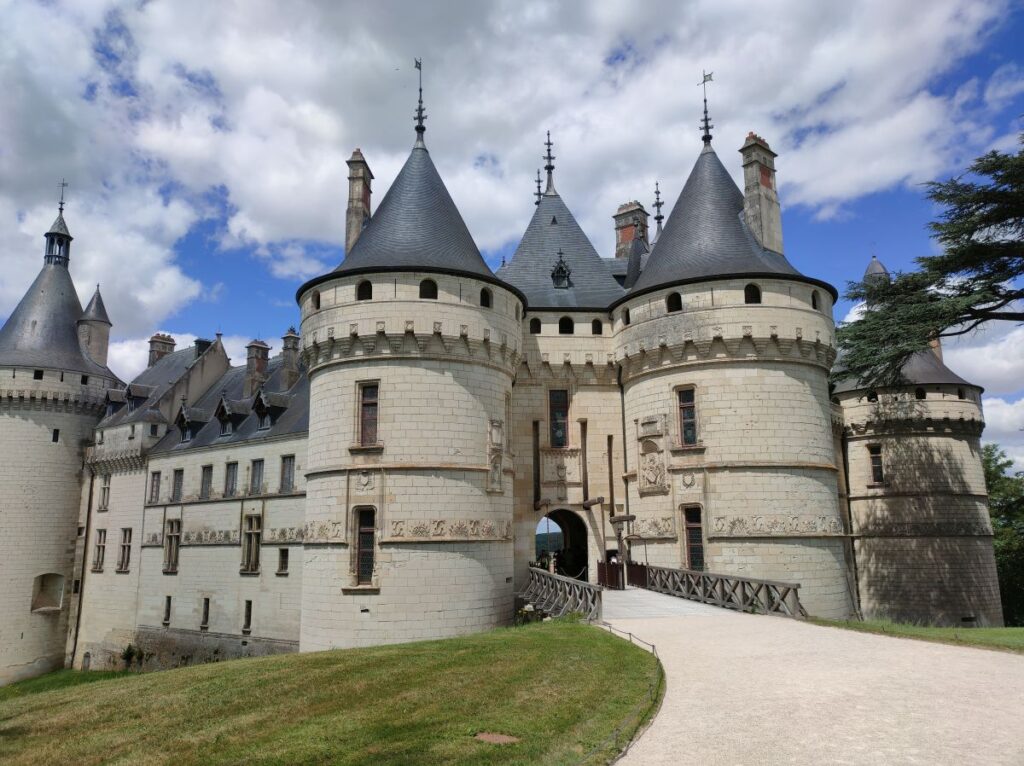
Contributed by Daniela from Ipanematravels.
Loire and its castles are a UNESCO World Heritage Site and Château de Chaumont is without a doubt one of the most beautiful castles in France. Located halfway between Blois and Amboise, this castle on the Loire River comes straight out of the fairy tales and attracts about 400,000 visitors per year.
Château de Chaumont was founded in the 11th century by Odo I Count of Blois, but it got its current appearance in the late 15th and early 16th centuries. In 1550 Catherine de Medici bought the castle but after the death of her husband Henry II, she traded it for the Château de Chenonceau with the mistress of her late husband. In the following centuries the castle changed owners often and ended up in the hands of Marie-Charlotte-Constance Say and her husband Prince Henri-Amédée de Broglie, who were the last private owners of the castle until 1938.
You can visit the historical apartments, all very well restored with preserved period details. Luckily, the north wing of the castle was demolished in the 18th century which opened the castle towards the river providing one of the most beautiful views over the Loire and its valley.
What sets Château de Chaumont apart, however, is its gardens. On the grounds of the castle each year the International Garden Festival is organized featuring contemporary garden designs from all over the world. Further Château de Chaumont is also a venue for numerous art exhibitions.
To visit Château de Chaumont, the art exhibitions, and the Garden Festival (April-November) you will need about 4 to 5 hours. Visiting only the castle, the stables and the park takes about 2-3 hours. There’s a fee for visiting the château.
Château du Hohlandsbourg, Wintzenheim, Grand Est
Contributed by Adriana from Wanderlicious.
There are a ton of fairytale castles in France and one of my favourites has to be Château du Hohlandsbourg near the charming village of Colmar, which you may have heard of thanks to its quaint and charming half timbered houses. It’s actually famed for being the place where Disney’s Beauty and the Beast was inspired by. But it’s worth a visit out of town; upon a hill in Alsace, France, stands Château du Hohlandsbourg, a time-weathered sentinel with views stretching across the Vosges and Rhine. It is a stunningly beautiful fairytale castle you should absolutely visit; the castle is built into the rock face and majestically overlooks the countryside. Its turbulent history spans eight centuries and when you are there you will learn about the numerous battles, reinventions, fortress duty, and reign of nobles and royals throughout history.
There isn’t any easily accessible public transport to Château du Hohlandsbourg itself, although it is only around 10-15 minutes from local towns Colmar and Eguisheim. You can access it by car, taxi or even hike the scenic trails leading to the castle. There is an admission fee of 7 EUR to enter for adults, but the experience is well worth it. Guided tours are available (just check at the counter what time they are running) and they are highly recommended so you can understand the castle’s history and architecture. A visit typically takes about 1-2 hours and is the perfect afternoon out.
Local recommendations include exploring the charming nearby towns of Colmar and Riquewihr, famous for their picturesque streets and Alsatian cuisine. Try local dishes like tarte flambée (a French style pizza) and Alsatian wine.
When visiting the castle, wear comfortable walking shoes and note that it’s not necessarily mobility friendly due to the rocky footpaths.
That’s a Wrap On Our Fairytale Castles in France
There are so many beautiful castles in France, let’s get on exploring.
Like it? Pin it!

Like it? Pin it!

Like it? Pin it!



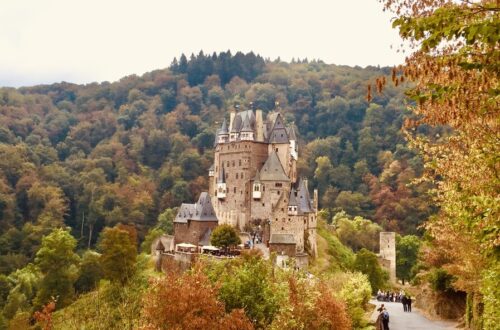
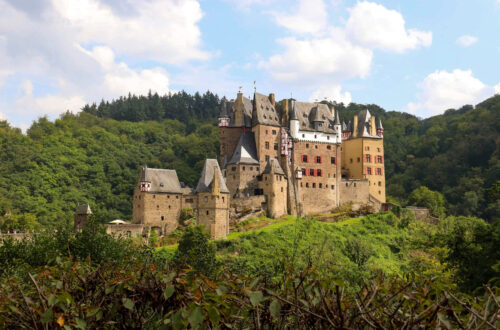
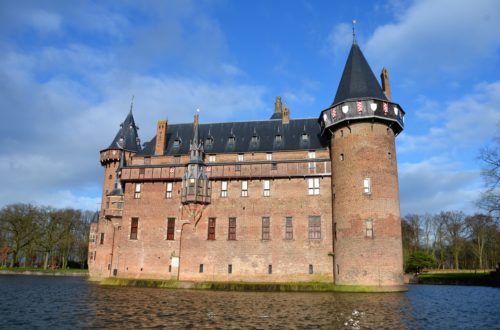
14 Comments
ANUKRATI DOSI
Château du Rivau, Lémeré, Centre-Val de Loire has to be favorite. That’s a fairytale castle for me.
Anita
I really appreciate the castles you suggest visiting in the article. I often try to visit castles during my travels, though I have only been to a few from this list. If I had to pick one to explore next, I would choose the Château de Chaumont. Thanks for sharing!
Laureen Lund
A fantastic list. I have been to a few of these but certainly not all of them. What a great inspriation to get back to France and explore some more!
Terri
I will never forget staying at a castle when I was travel hopping in Europe in my 20s. It was the most magical experience in my life. Highly recommend!
simplyjolayne
This post makes me want to go back to France, especially to the South of France and do some more exploring.
Away to the City
What a delightful list of fairytale castles! Your detailed insights into each castle’s history and charm make us want to pack our bags immediately. We’ve visited a few of them but spotted a few we hadn’t known. It’s given us plenty of inspiration for our next castle-themed adventure! Thank you! Viola and Sebastian from Away to the City x
Tara | Silly Little Kiwi Blog
Beautiful castles! Looks like a real-life fairytale.
Sharyn McCullum
Great list of castles. I’ve been to a few, but can’t remember all of them because after seeing a few I became ‘all castled out’! I’d love to go back and spend months in France to see them again.
Adéle Land
Wow! It’s incredible how many castles there are in France! Such an informative post!
Jennifer L Prince
Oh my goodness! There are so many lovely ones. I love how so many have stunning vantage points and views. I’d also love to roam through some of the gardens and portrait galleries. Haut-Koenigsbourg may be my favorite, but it’s hard to pick! 🙂
kmf
Loving these fairytale castles in France! Stunning and so much history! Would love to explore all of them.
Ashlea
The US has so much great history, but they can’t compete with the castles of Europe. Thanks for sharing!
MicheleinPlaya
So far I have only made it to Versailles and the Chateau at Fontainebleau. Now I have a whole list of other castles to visit the next time we are traveling in France!!
Sonia
I’ve only seen a few of these castles. This is a great collection of places to add to my travel list.